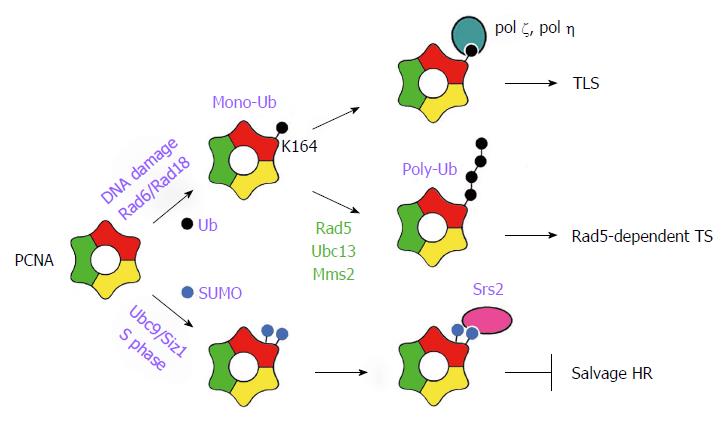Copyright
©The Author(s) 2015.
World J Biol Chem. Aug 26, 2015; 6(3): 48-56
Published online Aug 26, 2015. doi: 10.4331/wjbc.v6.i3.48
Published online Aug 26, 2015. doi: 10.4331/wjbc.v6.i3.48
Figure 1 DNA damage tolerance mechanisms.
DNA damage (asterisk in blue circle) stalls DNA replication. A: Reinitiation of DNA synthesis results in the formation of a ssDNA gap. Shown is a ssDNA gap on the lagging strand; B: PCNA mono-ubiquitination induces a switch from replicative polymerase to a TLS polymerase Pol ζ or Pol η, resulting in gap filling via TLS, which may incorporate the wrong nucleotide (asterisk in green circle); C-E: PCNA poly-ubiquitination activates the Rad5-dependent error-free TS pathway. Gap filling is achieved by strand invasion mediated by Rad51, Rad52, Rad54, and Rad55/Rad57 and repair synthesis carried out by Pol δ (C), followed by the formation of SCJ (D), and resolution of the SCJ by Sgs1/Top3/Rmi1 (E). DDT can also proceed through the salvage HR pathway that also produces the SCJ intermediate. The salvage pathway is hyper-recombinogenic and prone to crossover as indicated. It is normally inhibited by sumoylated PCNA and Srs2. G2: Gap 2; M: Mitotic; PCNA: Proliferating cell nuclear antigen; S: Synthesis; SUMO: Small ubiquitin-like modifier; TLS: Translesion synthesis; SCJ: Sister chromatid junction; Ub: Ubiquitin.
Figure 2 Regulation of DNA damage tolerance by proliferating cell nuclear antigen modification.
PCNA is a homotrimer that can be modified at K164 by either ubiquitin or SUMO. It can also be sumoylated at K127. PCNA mono-ubiquitination (mono-Ub) by Rad6/Rad18 facilitates the recruitment of TLS polymerases thereby promoting TLS. Extension of mono-Ub with a K63-linked Ub chain (poly-Ub) by Rad5/Ubc13/Mms2 promotes Rad5-dependent error-free TS pathway. PCNA sumoylation recruits Srs2 that inhibits the salvage HR pathway. HR: Homologous recombination; K: Lysine; PCNA: Proliferating cell nuclear antigen; S: Synthesis; SUMO: Small ubiquitin-like modifier; TLS: Translesion synthesis; TS: Template switching; Ub: Ubiquitin.
- Citation: Bi X. Mechanism of DNA damage tolerance. World J Biol Chem 2015; 6(3): 48-56
- URL: https://www.wjgnet.com/1949-8454/full/v6/i3/48.htm
- DOI: https://dx.doi.org/10.4331/wjbc.v6.i3.48










